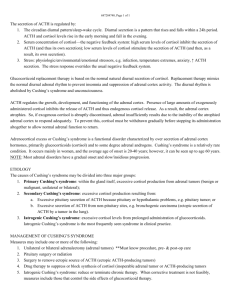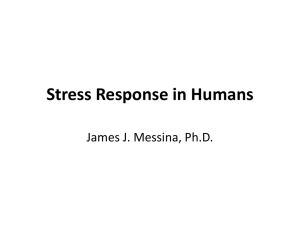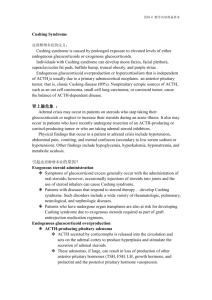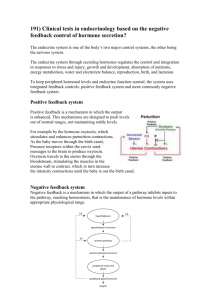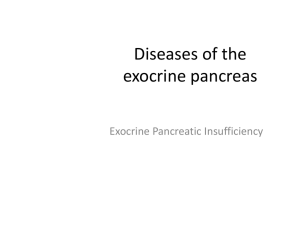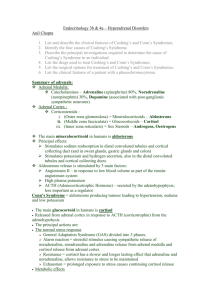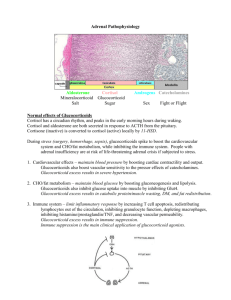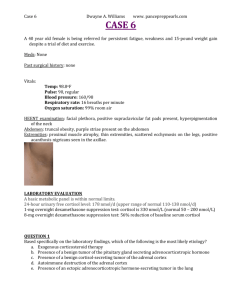Hyperthyroidism - Graves` disease
advertisement
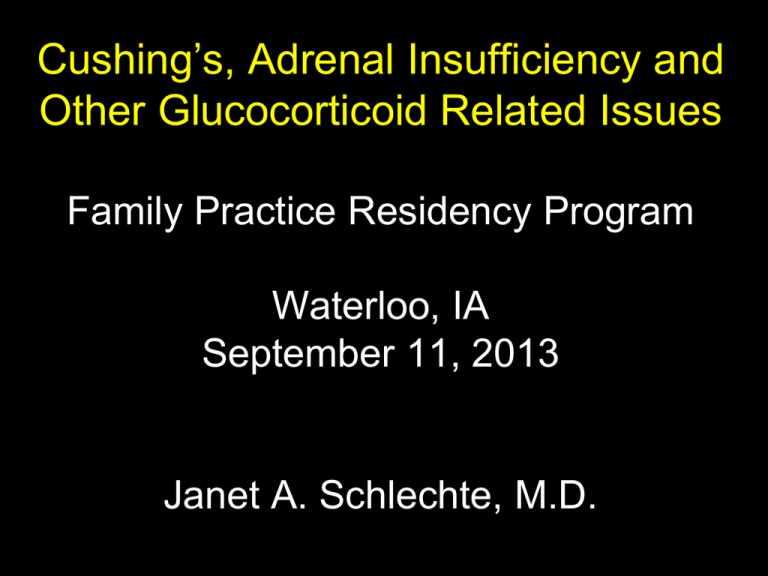
Cushing’s, Adrenal Insufficiency and Other Glucocorticoid Related Issues Family Practice Residency Program Waterloo, IA September 11, 2013 Janet A. Schlechte, M.D. Disclosure of Financial Relationships Janet A. Schlechte, M.D. has no relationships with any proprietary entity producing health care goods or services consumed by or used on patients. Objectives • Approach to glucocorticoid excess • Management of adrenal insufficiency • Peri-op management of glucocorticoids • Steroid taper Cushing’s Syndrome Causes • ACTH secreting pituitary tumor • Adrenal adenoma/carcinoma • Ectopic ACTH production • Exogenous glucocorticoid Classic Features of Cushing’s • Centripetal obesity • Violaceous striae • Proximal muscle weakness • Amenorrhea • Thin skin • Bruising Other Features of Cushing’s • Hypertension • Glucose intolerance • Diabetes • Hypokalemia • Bone loss Causes of Cushing’s Syndrome • ACTH secreting pituitary tumor • Adrenal adenoma/carcinoma • Ectopic ACTH production • Exogenous glucocorticoid Pituitary versus Adrenal Cushing’s Ectopic ACTH Secretion • Severe hypokalemia • Metabolic alkalosis • Muscle weakness • Few of the classic stigmata • Hyperpigmentation Cushing’s Syndrome • Rare disorder • How often will it present in the primary care setting? • Many people complain of weight gain and bruising but few have Cushing’s • Even astute clinicians should screen for glucocorticoid excess Screening Tests • 24 hour urine cortisol • 1 mg dex test • 11 p.m. salivary cortisol 24 Hour Urine Cortisol • Inconvenient but most sensitive • May need to do more than one unless results are 2-3x normal • Occasional false positives 16 Diurnal Variation of Cortisol 14 Cortisol 12 10 Pre-Dex 8 6 4 Post-Dex 2 2400 0500 1000 Time 1500 2000 1 mg Dex Test • 1 mg dexamethasone at 11 p.m. and measure 8 a.m. cortisol the next day • Healthy subjects will have cortisol <2 µg/dl 1 mg Dex Test • false positives - dilantin - obesity - estrogen - stress - depression A 30 y.o. woman has gained 20 pounds over the last six months. She has also noted leg swelling and her blood pressure is harder to control. She takes HCTZ and a BCP. B/P 140/100, BMI 35, bruises on legs, buffalo hump, pale pink striae. • She has read about Cushing’s syndrome and is worried about a pituitary tumor • Potassium 3.8, A1C 5.6%, CBC nl • She takes 1 mg of dex at 11 p.m. and an 8 a.m. cortisol the next day is 10 µg/dl. • Does she have Cushing’s? • She collects a 24 hour UFC and the result is 53 µg/dl (<50) • Does she have Cushing’s? A 40 y.o. man has poorly controlled hypertension. His weight has increased by 50 lb in the last year. He has bright purple striae and significant muscle weakness. A 1 mg DST shows a cortisol of 20 so screening test is positive. • To rule out a false positive do confirmatory test • He collects a 24 hour UFC and the value is 350 µg/dl (<50) • Test is positive – he has Cushing’s • Now what? When cortisol excess is confirmed draw ACTH ACTH Pituitary tumor Adrenal tumor Ectopic Glucocorticoid Excess Screening Test Normal Abnormal Confirm Test Stop Normal Abnormal Get ACTH Undetectable Adrenal Stop Elevated Pituitary Ectopic Do DST to differentiate ACTH Cortiso l Pituitary Hyperfunction ACTH Cortiso l Adrena l Tumor ACTH Cortiso l Ectopic Production Urinary free cortisol baseline 300 µg 989 µg 4034 µg 2 mg 180 991 4000 8 mg 40 990 3989 ACTH undet. A 41 y.o. collapsed on the golf course in August. For 6 months he has been tired with intermittent nausea, abdominal pain and deterioration of his golf game. In the ER his BP was 60/with a pulse of 130. He has a deep tan, pigmented buccal mucosa, a small thyroid and a normal neuro exam. In The ER • Sodium • Potassium • Chloride • CO2 • Creatinine • Glucose 125 6.4 98 18 1.4 75 Features of Primary AI • Hyperpigmentation • Fatigue and weakness • Hypotension • Postural dizziness • Abdominal pain • Weight loss Causes of Primary Adrenal Insufficiency • Autoimmune • Adrenal hemorrhage • Granulomatous disease • Your working diagnosis is primary adrenal insufficiency. • How do you confirm your suspicion? • Cortrosyn stimulation test - Measure plasma cortisol before and 1 hour after IM injection of 250 µg ACTH (cortrosyn) Short Cortrosyn Stimulation Test Cortisol Normal 1° AI • After cortrosyn stimulation test begin steroid replacement. • Little practical reason to start dexamethasone before cortrosyn. After the cortrosyn test the IV saline is continued and you give the 100 mg of hydrocortisone. One hour later the lab calls with the cortisol results. • Basal cortisol 0.1 µg/dl • Stimulated cortisol 0.1 µg/dl What if the results were • Basal cortisol 9 µg/dl • Stimulated cortisol 25 µg/dl Classical Glucocorticoid Equivalents Daily Replacement Doses 5 mg 20-25 mg Prednisone Hydrocortisone 0.75 mg Dexamethasone 37.5 mg Cortisone acetate More Physiologic Equivalents Daily Replacement Doses 5 mg Prednisone 10-15 mg Hydrocortisone 0.75 mg Dexamethasone Treatment Guidelines • Monitor therapy clinically and with electrolytes. • Can’t use ACTH or cortisol to monitor therapy. • Consider other autoimmune disease. Long-Term Therapy • Hydrocortisone (10-15 mg/day) • Start with hydrocortisone and add florinef as needed. • Florinef (0.05-0.1 mg/day) • Educate patient about use of steroid during “stress” • Yearly follow-up Stress dose? • Pulling wisdom teeth • Colonoscopy • Endometrial biopsy • Flu with aches and pains Stress dose? • CABG • Hip replacement • Final exams • Death in the family A 45 y.o. woman with RA has been treated with 10 mg of prednisone for 3 years. She will undergo laparoscopic surgery in 2 days. Her surgeon wants you to write pre-op orders. • Pituitary adrenal axis is suppressed • ACTH due to exogenous glucocorticoid • Stopping glucocorticoid and/or stress of surgery could lead to adrenal crisis Peri-Operative Corticosteroid Coverage • Minor surgical stress - usual dose day of procedure • Moderate surgical stress - 50 mg HC day of procedure then resume usual dose Ann Surg 219:416, 1994 Peri-Operative Corticosteroid Coverage • Major surgical stress - 100 mg HC on day of procedure - 50 mg HC on post-op day 1 • Resume usual dose unless clinical condition deteriorates Ann Surg 219:416, 1994 • Avoid too much glucocorticoid • After a stress dose rapidly resume the replacement dose • Don’t use cortisol or ACTH to try to monitor therapy A 60 y.o. man has taken 60 mg of prednisone daily for 6 months for anterior ischemic optic neuropathy. His ophthalmologist has seen no improvement and wants to stop the steroid. The Dilemma • Stopping the drug will lead to secondary adrenal insufficiency • He has muscle weakness and weight gain and his T score is -2.9. The glucocorticoid needs to be stopped as rapidly as possible Taper Option # 1 January 1 January 15 January 30 February 1 February 15 March 1 60 mg 40 mg 20 mg 10 mg 5 mg Off Taper Option # 2 January 1 January 15 February 1 March 1 April 1 60 mg 60 mg q.o.d. 30 mg q.o.d. 10 mg q.o.d. Off Taper Option # 3 January 1 60 mg January 2 10 mg February 1 9 mg March 1 8 mg April 1 7 mg May 1 6 mg etc. until off Questions to Ask • What is the reason for the taper? • Is it to avoid recurrence of disease? • Is it to avoid adrenal crisis? Effect of Dose of Hydrocortisone on Mortality 0<HC<20 RR 1.3 95% CI 0.7-2.6 p ns 20<HC<25 1.4 0.6-3.3 ns 25<HC<30 1.6 1.1-2.4 .014 HC>30 2.9 1.4-5.9 .003 JCEM 94:4216, 2009 Take Home Points • Remember glucocorticoid equivalencies • Use stress doses sparingly • When HPA axis is suppressed, taper slowly beginning at a maintenance dose A 42 y.o. with a history of chronic back pain has severe fatigue and the lab pages you because his cortisol is 1.0 and his TSH is 1.4. One of your patients takes 5 mg of prednisone daily after an organ transplant. She is having her wisdom teeth pulled tomorrow morning and calls to find out what to do about her prednisone since she will be NPO.


